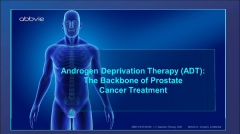
|Videos|April 14, 2023
ADT as the Backbone for Combination Treatments in Advanced Prostate Cancer
A focused discussion on how ADT is used as the backbone of prostate cancer therapy across different prostate cancer risk groups and according to metastatic and castration sensitivity status.
Advertisement
Newsletter
Stay up to date on recent advances in the multidisciplinary approach to cancer.
Advertisement
Advertisement
Advertisement
Trending on CancerNetwork
1
SABCS 2025: The Top 5 Takeaways for Breast Cancer Research
2
Novel Anti-BCMA Agent Shows Preliminary Responses in R/R Multiple Myeloma
3
Imlunestrant Combo Will Not Be Pursued for FDA Approval in Breast Cancer
4
RAD51 Test May Improve Patient Selection of Olaparib in BRCA1/2 or PALB2 HER2– Breast Cancer
5






















































































